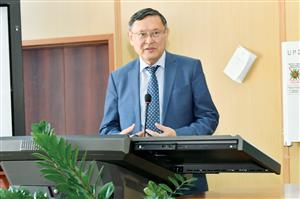- Main page
- News
TIMUR ZHANTIKIN, GENERAL DIRECTOR OF KAZAKHSTAN NUCLEAR POWER PLANTS LLP: KAZAKHSTAN MOVES TOWARDS GREEN ECONOMY
11/15/2022
The Department of Theory and Nuclear Physics of the Faculty of Physics and Technology of the Al-Farabi Kazakh National University hosted a leadership lecture on the topic "Prospects for the Construction of NPP in Kazakhstan" by Timur Miftakhuly Zhantikin, Director General of Kazakhstan Nuclear Power Plants.
The speaker was introduced by the Dean of the Faculty of Physics and Technology Nurzada Beisen. Timur Zhantikin is a graduate of Novosibirsk State University and laureate of the Russian Government Prize in science and Technology. Since 2016 he has been the General Director of Kazakhstan Nuclear Power Plants. The company is engaged in activities in the field of architecture for nuclear industry and nuclear power facilities; research and experimental developments in the field of peaceful use of atomic energy.
The construction of a nuclear power plant is one of the pivotal tasks on the agenda of Kazakhstan. As you know, the head of state instructed to study and professionally develop in this area. Due to the steady increase in consumption of electricity, the energy shortages happen quite frequently. In this regard, the President noted that one of the effective solutions is the construction of a nuclear power plant. In his lecture atomic scientist Timur Zhantikin has shared his thoughts about nuclear energy and how to turn it into electricity:
“As you may know that now there is a transition to green economy. In this direction there is the UN Sustainable Development Goal, which all countries have adopted. Kazakhstan is at the forefront of moving towards green economy. First of all, this concerns the reduction of greenhouse gas emissions in the energy sector. Most attention is paid to thermal effects, which are emissions to the atmosphere associated with the operation of energy sources. In Kazakhstan almost 80% of energy is used at coal-fired power plants. On the other hand, Kazakhstan has been mining uranium for several years, but all uranium is exported, while we have almost no consumption. It goes for peaceful purposes to the nuclear power industry of other countries. Having uranium mining, having the final stage of the nuclear fuel cycle, we have the largest uranium plant, which in the Soviet times produced up to 80% of all nuclear fuel of Soviet reactors and countries of the socialist camp. At that time, quite a lot of fuel went abroad.”
Last year, a joint venture for the production of nuclear fuel was launched on the basis of the Ulba plant. There fuel is produced using French technology for nuclear reactors of China. Nuclear fuel is a high–tech product, so it is necessary to undergo a complex and step-by-step certification.
The first nuclear power plant worked in our country in 1954, a fast neutron reactor was launched in Aktau (then the city of Shevchenko). It was called "Mangishlak Nuclear Power Plant". This technology is just beginning to develop now. In 1998 it was decided to shut it down, because the station has passed the assigned period and further operation was difficult. Therefore, we have started a decommissioning project for this reactor. Naturally, it would be logical to build a substitute similar object that would give energy using a peaceful atom. Such a project was launched and in 1996 a feasibility study was prepared for the construction of the Balkhash nuclear power plant based on innovative VVER 640 reactors. Then the project was frozen due to lack of financial resources. The second attempt was in the early 2000s, the construction of two units of VVER-300 reactors was planned on the site of the decommissioning VVER 250. Now we are conducting the third project. These are standard reactors available on the market of the third generation. The capacity is 1000-1400 MW per unit with its inclusion in the power system of Kazakhstan.
The reactors have an improved safety system, the duration of operation is sixty years. Among the projects described above, we looked at those that are well proven on the market, sent out an invitation to the leading companies of the world to participate in our project. Six companies from five countries responded. Technical and commercial proposals were received from six vendors from China, Korea, Russia, the USA and France. Factors considered:
• Earthquakes and geological phenomena
• Hydro-meteorological conditions
• Hydrological conditions
• Forecast water consumption
• The impact of nuclear power plants construction on the flora and fauna of the surrounding area
• The impact of nuclear power plants operation on the hydrography of the area
At the end of the lecture, the audience received detailed answers to all their questions about nuclear energy.
Kairzhan TUREZHANOV

